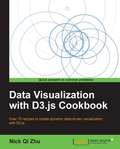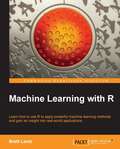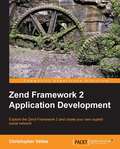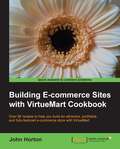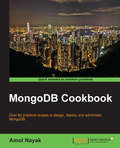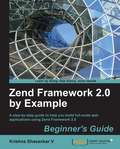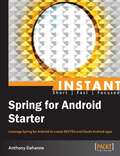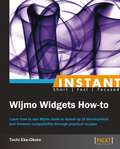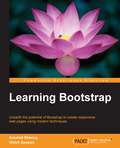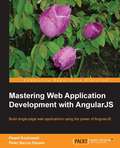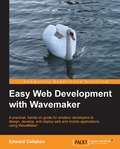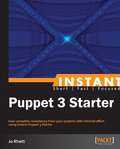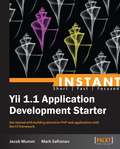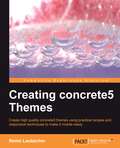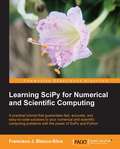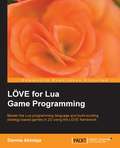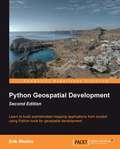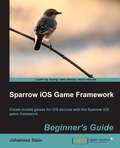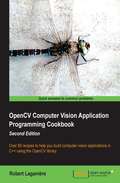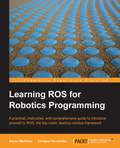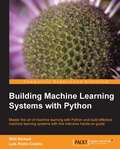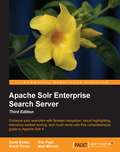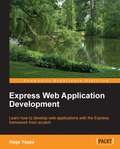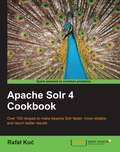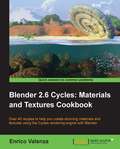- Table View
- List View
Data Visualization with D3.js Cookbook
by Nick Qi ZhuPacked with practical recipes, this is a step-by-step guide to learning data visualization with D3 with the help of detailed illustrations and code samples.If you are a developer familiar with HTML, CSS, and JavaScript, and you wish to get the most out of D3, then this book is for you. This book can also serve as a desktop quick-reference guide for experienced data visualization developers.
Machine Learning with R
by Brett LantzWritten as a tutorial to explore and understand the power of R for machine learning. This practical guide that covers all of the need to know topics in a very systematic way. For each machine learning approach, each step in the process is detailed, from preparing the data for analysis to evaluating the results. These steps will build the knowledge you need to apply them to your own data science tasks.Intended for those who want to learn how to use R's machine learning capabilities and gain insight from your data. Perhaps you already know a bit about machine learning, but have never used R; or perhaps you know a little R but are new to machine learning. In either case, this book will get you up and running quickly. It would be helpful to have a bit of familiarity with basic programming concepts, but no prior experience is required.
Zend Framework 2 Application Development
by Christopher VallesThe book is really pragmatic, focusing on the key aspects you usually need to create an application. We skip the boring theory and jump straight to the action. Also, the examples don't try to be perfect, they just show the topic in question or the tool/components we are using. Here the focus is on the framework itself not on how to architect applications. The book will spend a lot of time reviewing the examples and each chapter is created around the example used to explain the topics so the example is first, then the explanation.This book is great for you if you are new to Zend Framework 2 and are looking to get a practical approach in how to use the framework. This book will be also really helpful if you are a Zend Framework 1 user but you want to adapt you knowledge to the new version of the framework. It's assumed that you will have good experience using PHP and specially with the Object Oriented programming paradigm.
Building E-commerce Sites with VirtueMart Cookbook
by John HortonWritten in a friendly, recipe-based style, this practical cookbook will show you how to create, maintain and customize attractive eCommerce solutions with ease.This book is written for anyone who is interested in building eCommerce solutions with VirtueMart. If you have little to no experience with eCommerce this book will show you how to overcome any problem no matter how complex it appears. Experienced site builders and administrators will also find the solutions this cookbook offers useful. Basic HTML and CSS would be beneficial.
MongoDB Cookbook
by Amol NayakIf you want a reference to show you practical solutions, or just want to satisfy your need for more knowledge of this fantastic NoSQL database, then this book is ideal for you. To get the most out of this book, you should know the basics of MongoDB.
Zend Framework 2.0 by Example: Beginner’s Guide
by Krishna Shasankar VZend Framework 2.0 by Example: Beginner's Guide is a step-by-step guide that aims to empower you to build web applications packed with some really exciting features using Zend Framework 2.0.If you are a PHP Developer who is new to Zend Framework, but you want to get hands-on with the product quickly, this book is for you. Basic knowledge of object oriented programming with PHP is expected.
Instant Spring for Android Starter
by Anthony DahannePackt Instant Starter: get to grips with a new technology, understand what it is and what it can do for you, and then get to work with the most important features and tasks.This is a Starter which gives you an introduction to Spring for Android with plenty of well-explained practical code examples.If you are an Android developer who wants to learn about RESTful web services and OAuth authentication and authorization, and you also want to know how to speed up your development involving those architectures using Spring for Android abstractions, then this book is for you.But core Java developers are not forgotten, thanks to the explanations on how to set up Eclipse and Maven for Android development (very basic knowledge regarding Android UI design is required to understand the examples; the right pointers to ramp up on this topic are provided though).
Instant Wijmo Widgets How-to
by Tochi Eke-OkoroFilled with practical, step-by-step instructions and clear explanations for the most important and useful tasks.A recipe-based instant tutorial, showing app development with Knockout and Wijmo, and covering major widgets and themes.This book aims at equipping the reader with the necessary tools that Wijmo and Knockout JS provide for easing and speeding up development. It addresses the needs of everyone in the UI development space, both experienced and newbies. To get the most out of this book you should have a good working knowledge of HTML, CSS, and JavaScript, and will need to be comfortable using jQuery.
Learning Bootstrap
by Aravind Shenoy Ulrich SossouIf you want to learn to build enterprise-level websites efficiently with Bootstrap, this book is for you. You must have a basic and fundamental understanding of HTML, CSS, and JavaScript; however, there is no need to have prior Bootstrap experience.
Mastering Web Application Development with AngularJS
by Pawel Kozlowski Peter Bacon DarwinThe book will be a step-by-step guide showing the readers how to build a complete web app with AngularJSJavaScript developers who want to learn AngularJS for developing web apps. Knowledge of JavaScript and HTML is expected. No knowledge of AngularJS is required.
Easy Web Development with WaveMaker
by Edward CallahanWritten as a practical Packt tutorial, this essential reference will help you use WaveMaker to design, develop, and deploy rich, responsive web applications. This book is for 'citizen developers'; amateur developers who want to build modern, responsive, but scalable web applications connected to database, REST, and Java services without all the effort. No specific technical knowledge is assumed. However, you will be interacting with numerous technologies throughout the course of this book. The more of those technologies you are familiar with, the easier you will find this book. This book is also good for developers looking to use WaveMaker as a tool to build quickly build AJAX browser clients to their web and Java services using the Spring Framework
Instant Puppet 3 starter
by Jo RhettGet to grips with a new technology, understand what it is and what it can do for you, and then get to work with the most important features and tasks. This book is an awesome guide for understanding and developing your skills set with instant Puppet 3. It consists of friendly practical tutorials, with an informative step by step walk through.Instant Puppet 3 helps to simplify your life for large scale computing clusters. It is aimed at systems administrators, developers, DevOps engineers and anyone who manages more than one computer. This is a practical and intuitive instant starter guide, guaranteed to improve your understanding and efficiency.
Instant Yii 1.1 Application Development Starter
by Jacob Mumm Mark SafronovGet to grips with a new technology, understand what it is and what it can do for you, and then get to work with the most important features and tasks. A concise guide that delivers immediate results with practical recipes that give you useful hints and tips on avoiding the pitfalls in Eclipse 4 development.This book is aimed at developers with some basic programming experience and a general understanding of relational databases, or anyone who is ready to take their development to the next level with framework-driven development. A basic understanding of MySQL, PHP, HTML, and HTTP is expected.
Creating Concrete5 Themes
by Remo LaubacherPractical guide to create Concrete5 themes.This book is great for theme developers new to concrete5 who are looking to use their experience in HTML and CSS to create high quality themes for concrete5. It's assumed that you have worked with HTML before and can also read code as you'll see some basic PHP and JavaScript code. There are a few words about using concrete5, but you're expected to spend a bit of time on your own to get familiar with the concrete5 interface by yourself and by reading some of the articles listed in the book. Readers are expected to have the ability to set up their own concrete5 site, but basic information about the installation and links to follow up are provided though.
Learning SciPy for Numerical and Scientific Computing
by Francisco J. Blanco-SilvaA step-by-step practical tutorial with plenty of examples on research-based problems from various areas of science, that prove how simple, yet effective, it is to provide solutions based on SciPy.This book is targeted at anyone with basic knowledge of Python, a somewhat advanced command of mathematics/physics, and an interest in engineering or scientific applications---this is broadly what we refer to as scientific computing.This book will be of critical importance to programmers and scientists who have basic Python knowledge and would like to be able to do scientific and numerical computations with SciPy.
LÖVE for Lua Game Programming
by Darmie AkinlajaThis book follows a tutorial approach with examples and step-by-step instructions to help explain the key concepts of the LÖVE framework as well as everything you need to know about game development using the Lua programming language.LÖVE2d for Lua Game Programming is for anyone who is interested in learning about desktop game development.
Python Geospatial Development, Second Edition
by Erik WestraThis is a tutorial style book that will teach usage of Python tools for GIS using simple practical examples and then show you how to build a complete mapping application from scratch. The book assumes basic knowledge of Python. No knowledge of Open Source GIS is required.Experienced Python developers who want to learn about geospatial concepts, work with geospatial data, solve spatial problems, and build map-based applications.This book will be useful those who want to get up to speed with Open Source GIS in order to build GIS applications or integrate Geo-Spatial features into their existing applications.
Sparrow iOS Game Framework Beginner’s Guide
by Johannes SteinAn easy-to-follow guide full of descriptive step-by-step procedures on how to develop a game for iOS. With each topic, a new challenge will be tackled to get a deeper knowledge of the Sparrow game framework and gain the skills to develop a complete mobile experience. This book is aimed at those who have always wanted to create their own games for iOS devices. Perhaps you've already dabbled in game development and want to know how to develop games for the Apple App Store, or maybe you have developed Objective-C apps in the past but you are new to game development. In either case, this book will help with descriptive examples and teach you to develop a game throughout its course. Some experience in Objective-C and a basic understanding of object-oriented programming are required.
OpenCV Computer Vision Application Programming Cookbook: Second Edition
by Robert LaganiereOpenCV 3 Computer Vision Application Programming Cookbook is appropriate for novice C++ programmers who want to learn how to use the OpenCV library to build computer vision applications. It is also suitable for professional software developers wishing to be introduced to the concepts of computer vision programming. It can also be used as a companion book in a university-level computer vision courses. It constitutes an excellent reference for graduate students and researchers in image processing and computer vision.
Learning ROS for Robotics Programming
by Enrique Fernandez Aaron MartinezThe book will take an easy-to-follow and engaging tutorial approach, providing a practical and comprehensive way to learn ROS.If you are a robotic enthusiast who wants to learn how to build and program your own robots in an easy-to-develop, maintainable and shareable way, "Learning ROS for Robotics Programming" is for you. In order to make the most of the book, you should have some C++ programming background, knowledge of GNU/Linux systems, and computer science in general. No previous background on ROS is required, since this book provides all the skills required. It is also advisable to have some background on version control systems, like svn or git, which are often used to share the code by the community.
Building Machine Learning Systems with Python
by Luis Pedro Coelho Willi RichertA practical, scenario-based tutorial, this book will help you get to grips with machine learning with Python and start building your own machine learning projects. By the end of the book you will have learnt critical aspects of machine learning Python projects and experienced the power of ML-based systems by actually working on them. This book is for Python programmers who are beginners in machine learning, but want to learn Machine learning. Readers are expected to know Python and be able to install and use open-source libraries. They are not expected to know machine learning, although the book can also serve as an introduction to some Python libraries for readers who know machine learning. This book does not go into the detail of the mathematics behind the algorithms. This book primarily targets Python developers who want to learn and build machine learning in their projects, or who want to provide machine learning support to their existing projects, and see them getting implemented effectively.
Apache Solr Enterprise Search Server - Third Edition
by David SmileyThis book is for developers who want to learn how to get the most out of Solr in their applications, whether you are new to the field, have used Solr but don't know everything, or simply want a good reference. It would be helpful to have some familiarity with basic programming concepts, but no prior experience is required.
JBoss AS 7 Development
by Francesco MarchioniThis book will kick-start your productivity and help you to master JBoss AS development. The author's experience with JBoss enables him to share insights on JBoss AS development in a clear and friendly way. By the end of the book, you will have the confidence to apply all the newest programming techniques to your JBoss applications.If you are a Java architect or developer who wants to get the most out of the latest release of the JBoss application server, then this book is for you. You are not expected to have accumulated experience on the application server though you must know the basic concepts of Java EE.
Apache Solr 4 Cookbook
by Rafal KucApache Solr 4 Cookbook is written in a helpful, practical style with numerous hands-on recipes to help you master Apache Solr to get more precise search results and analysis, higher performance, and reliability. This book is for developers who wish to learn how to master Apache Solr 4. This book will specifically appeal to developers who wish to quickly get to grips with the changes and new features of Apache Solr 4. This book is also handy as a practical guide to solving common problems and issues when using Apache Solr.
Blender 2.6 Cycles:Materials and Textures Cookbook
by Enrico ValenzaWritten in a friendly, practical style this Cookbook deep-dives into a wide-array of techniques used to create realistic materials and textures.This book is perfect for you if you have used Blender before but are new to the impressive Cycles renderer. You should have some knowledge of the Blender interface, though this is not a strict requirement. If you want to create realistic, stunning materials and textures using Cycles, then this book is for you!
